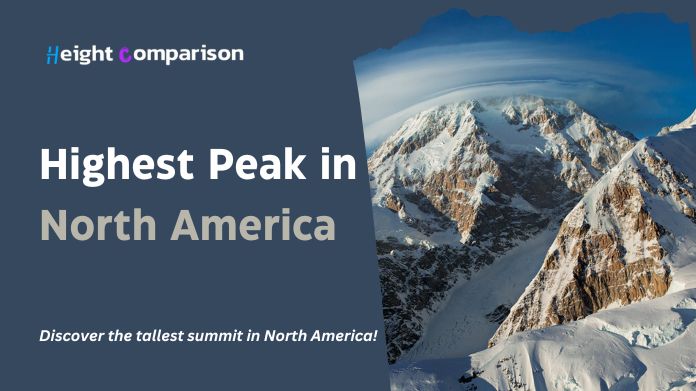North America is home to diverse landscapes, with towering mountain ranges among its most prominent features. At the pinnacle of this rugged terrain lies the continent’s highest peak, a majestic summit revered by climbers and adventurers worldwide.
In this Height Comparison article, we embark on a journey to discover the highest peak in North America, exploring its imposing stature, geographical significance, and allure to outdoor enthusiasts.
Whether you’re drawn to the challenge of scaling its formidable slopes or simply marveling at its awe-inspiring beauty from afar, this peak commands attention and admiration.
Join us as we uncover the heights and depths of North America’s tallest mountain, a symbol of nature’s grandeur and the human spirit of exploration.
Overview of Highest Peak in North America

Unveiling Denali
Denali, formerly known as Mount McKinley, reigns supreme as the highest peak in North America, soaring to an elevation of 20,310 feet (6,190 meters) above sea level.
Nestled within the heart of the Alaska Range, Denali dominates the landscape with its snow-capped summit and rugged slopes. The mountain’s name, “Denali,” originates from the Koyukon Athabaskan language and means “The High One” or “The Great One,” a fitting tribute to its lofty status.
| Category | Information |
|---|---|
| Location | Alaska, United States |
| Coordinates | 63°04′10″N 151°00′27″W |
| Area | 19,000 square miles (49,000 sq km) |
| Built For | Natural formation |
| Dimensions | Elevation: 20,310 feet (6,190 meters) |
| Architectural Style | Natural formation |
| No. of Visitors Every Year | Varies depending on tourism trends |
| Governing Body | Denali National Park and Preserve (Government Property) |
Geographical Significance
Denali’s prominence extends beyond its impressive height, as it holds significant geographical importance. As part of the Alaska Range, Denali forms a critical watershed divide, separating the watersheds of the Pacific Ocean to the south and the Arctic Ocean to the north.
Its massive size and remote location contribute to its unique ecosystem, supporting diverse flora and fauna adapted to the harsh alpine environment.
Challenges of the Climb
Ascending Denali is no small feat, as climbers face many challenges navigating its treacherous terrain and unpredictable weather conditions.
The mountain’s extreme altitude, frigid temperatures, and fierce winds present formidable obstacles, testing the endurance and skills of even the most experienced mountaineers. Denali’s notorious weather patterns, including sudden storms and whiteout conditions, demand careful planning and preparation for safe passage.
Historical Information
What is the Origin and History?
- Denali is a natural formation with the highest mountain peak in North America.
- The Koyukon people have called it “Denali” for centuries.
- In 1896, a gold prospector named it “Mount McKinley” after President William McKinley.
Who Built It, and When Was It Constructed?
- Denali is a natural feature and was not built by humans.
- It was formed by tectonic activity around 56 million years ago.
- Erosion and glacial activity have shaped the mountain over time.
What Was Its Purpose or Significance?
- Denali is sacred to the indigenous Koyukon people.
- “Denali” comes from the Koyukon word “Deenaalee,” meaning “the tall one.”
- It is a challenging and prestigious climbing opportunity for mountaineers.
- The first successful summit was in 1913.
- The area was established as a national park in 1917 to preserve its natural beauty and wildlife.
- The mountain’s name was officially changed back to Denali in 2015 to recognize its historical and cultural significance.
Cultural and Tourist Aspects
What is Its Cultural Significance or Mythology?
- Denali holds great cultural significance for the indigenous Koyukon people.
- They consider the mountain sacred and have a deep spiritual connection to it.
- In Koyukon mythology, Denali is said to be home to a female spirit who controls the weather and animals.
- The mountain is also believed to be where the spirits of the dead reside.
How Popular is It Among Tourists?
- Denali National Park and Preserve attracts hundreds of thousands of visitors each year.
- In 2019, the park recorded over 601,000 visitors.
- Tourists come to experience the stunning natural beauty, wildlife, and outdoor activities.
- Many visitors see Denali, even if they don’t intend to climb it.
- The mountain’s grandeur and iconic status make it a popular attraction.
What Events or Ceremonies Are Associated With It?
- The Koyukon people have traditional ceremonies and rituals associated with Denali.
- These ceremonies are private and not typically shared with outsiders.
- For climbers, reaching the summit of Denali is a significant personal achievement.
- The National Park Service holds ranger-led programs and events to educate visitors about the mountain’s natural and cultural history.
- June 21, the summer solstice, is a popular time for events and gatherings near the mountain. It marks the longest day of the year in the northern hemisphere.
Conclusion
Denali is an iconic symbol of North America’s majestic beauty and natural grandeur. Its towering height, rugged terrain, and rich cultural heritage make it a revered destination for adventurers and nature enthusiasts alike.
As the continent’s highest peak, Denali beckons explorers to conquer its challenging slopes and experience the thrill of summiting one of the world’s most iconic mountains. Beyond its physical stature, Denali embodies the spirit of resilience and perseverance, serving as a testament to humanity’s quest for exploration and discovery.
Whether admired from afar or scaled by intrepid climbers, Denali leaves an indelible mark on all who encounter its awe-inspiring presence, inspiring a deep appreciation for the boundless wonders of the natural world.
As we marvel at Denali’s majestic heights, let us also recognize the importance of preserving and protecting this pristine wilderness for future generations to enjoy and cherish.






